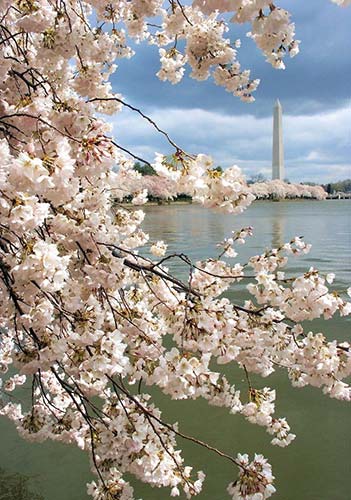By Tacy Lambiase

The arrival of Washington’s cherry blossoms is a highly anticipated event that draws thousands of people to the National Mall and Tidal Basin every year. Since 1935, the Cherry Blossom Festival has marked this annual occasion with parades, performances and exhibits. This year’s festivities will surely be no exception. But while many people flock to our nation’s capital to enjoy the visual splendor of cherry trees in bloom, the historical significance of these trees should also be celebrated.
It may be common knowledge that the original 3,020 cherry trees planted in Washington, D.C., were a gift of friendship from the nation of Japan to the United States. According to the National Park Service, in 1912, these trees were shipped by boat from Yokohama, Japan, to Seattle, where they were then loaded onto a train bound for Washington. Upon the arrival of the trees in late March, First Lady Helen Taft and Viscountess Chinda, wife of the Japanese Ambassador, held a ceremony to honor the friendship between their two countries. They planted the first two cherry trees on the north end of the Tidal Basin. From 1913 to 1920, nearly 1,800 cherry trees of the Somei-Yoshino variety were also planted along the basin. The other 11 varieties took root in East Potomac Park and on the grounds of the White House.
While initially given as a gift, these cherry trees have become part of a long-term exchange of culture and blossoms between Japan and the United States. In 1965, the Japanese government gave 3,800 more cherry trees to “Lady Bird” Johnson, an environmental enthusiast and First Lady. Many of these trees were planted around the Washington Monument. Later, in 1982, the United States allowed Japan to take hundreds of cuttings from the trees by the Tidal Basin to grow cherry trees with a similar genetic make-up. These would replace many cherry trees that had been destroyed in Japan when a river’s original course was altered. These and other gestures involving cherry trees have come to symbolize the enduring friendship and peace between the United States and Japan. Hopefully, these trees will continue to foster goodwill and an appreciation of trees for many years to come.
Although Tokyo’s cherry trees bloomed early this year, residents of Washington, D.C., have been patiently waiting for the District’s trees to show signs of spring. Horticulturalists with the National Park Service, however, have predicted that “Peak Bloom Date” for this year’s buds will happen this week–between April 3 and April 6. According to the Park Service, the Peak Bloom Date is defined as the day when 70 percent of the blooms are open on the cherry trees surrounding the Tidal Basin. Although the blooming period starts a few days before this date, and can last as long as two weeks, be strategic when planning your visit to see these beautiful trees in action.
Can’t make it to this year’s Cherry Blossom Festival? Watch the Smithsonian’s beautiful timelapse video of last year’s blooms: